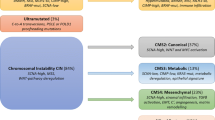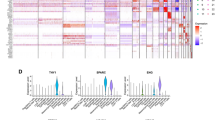Abstract
Purpose
The hedgehog (Hh) pathway is involved in cancer stem cell (CSC) maintenance in various tumors. Glioma-associated oncogene homolog 1 (Gli1) is a key mediator of the Hh pathway; however, its expression and clinical significance in esophageal squamous cell carcinoma (ESCC) have not been reported. In this study, we aimed to reveal clinical significance of Gli1 expression in ESCC and further investigate the potential of Gli1 as a CSC regulator of ESCC by comparing its expression with expressions of other stemness genes in ESCC.
Methods
We assessed the expressions of Gli1, Sox9, CD44, Sox2, LSD1, and Oct4 in 127 patients’ tissue specimens of ESCC using immunohistochemistry and in ESCC cell lines using Western blotting. The relationship of Gli1 expression with clinic–pathologic parameters as well as cell-cycle-regulating genes was investigated. We also investigated the biological pathways that are activated in Gli1-high ESCC using The Cancer Genome Atlas (TCGA) data.
Results
Gli1 expression was observed in 28.3 % of ESCC, and its expression was correlated with the expression of stemness genes, Sox9 (P = 0.003) and CD44 (P = 0.012). And Gli1, CD44, and Sox9 were highly expressed in more poorly differentiated ESCC cell lines such as TE8 and TE1 cells. Notably, Gli1 expression was positively associated with distant metastasis (P = 0.011), increased microvessel density (MVD) (P = 0.002), and expression of cell cycle regulators such as p21, cyclin D1, cyclin E1, and NF-κB (P < 0.05). Sox9 and CD44 expressions in ESCC were also significantly associated with unfavorable clinic–pathologic parameters such as increased MVD, advanced tumor (pT) stage, and higher TNM stage. Moreover, all three potential CSC markers such as Gli1, Sox9, and CD44 were strongly linked to worse clinical outcome and independent poor prognostic factors in overall survival and disease-free survival in ESCC. Gene set enrichment analysis revealed that the Gli1-high-expressing ESCC patients’ group was strongly enriched for gene expression signature of Hh signaling pathway, epithelial–mesenchymal transition, and cancer stem cell.
Conclusions
Targeting Gli1, a potential diagnostic marker of ESCC stem cells, will have a profound therapeutic and prognostic value.






Similar content being viewed by others
References
Abbas T, Dutta A (2009) p21 in cancer: intricate networks and multiple activities. Nat Rev Cancer 9(6):400–414
Boopalan T, Arumugam A, Parada J et al (2015) Receptor activator for nuclear factor-κB ligand signaling promotes progesterone-mediated estrogen-induced mammary carcinogenesis. Cancer Sci 106:25–33
Bora-Singhal N, Perumal D, Nguyen J et al (2015) Gli1-mediated regulation of Sox2 facilitates self-renewal of stem-like cells and confers resistance to EGFR inhibitors in non-small cell lung cancer. Neoplasia 17(7):538–551
Clement V, Sanchez P, de Tribolet N et al (2007) HEDGEHOG-GLI1 signaling regulates human glioma growth, cancer stem cell self-renewal, and tumorigenicity. Curr Biol 17:165–172
Colavito SA, Zou MR, Yan Q et al (2014) Significance of glioma-associated oncogene homolog 1 (GLI1) expression in claudin-low breast cancer and crosstalk with the nuclear factor kappa-light-chain-enhancer of activated B cells (NFκB) pathway. Breast Cancer Res 16:444–462
Cui D, Chen X, Yin J et al (2012) Aberrant activation of Hedgehog/Gli1 pathway on angiogenesis in gliomas. Neurol India 60:589–596
de Carcer G, Perez DCI, Malumbres M (2007) Targeting cell cycle kinases for cancer therapy. Curr Med Chem 14(9):969–985
Deng W, Vanderbilt DB, Lin CC et al (2015) SOX9 inhibits β-TrCP-mediated protein degradation to promote nuclear GLI1 expression and cancer stem cell properties. J Cell Sci 128(6):1123–1138
Du L, Wang H, He L et al (2008) CD44 is of functional importance for colorectal cancer stem cells. Clin Cancer Res 14:6751–6760
Gotoda T, Matsumura Y, Kondo H et al (2000) Expression of CD44 variants and prognosis in oesophageal squamous cell carcinoma. Gut 46:14–19
Guo JF, Gao J, Li Z, Gong Y et al (2013) Adenovirus vector-mediated Gli1 siRNA induces growth inhibition and apoptosis in human pancreatic cancer with Smo-dependent or Smo-independent Hh pathway activation in vitro and in vivo. Cancer Lett 339:185–194
Hong Y, Chen W, Du X et al (2015) Upregulation of sex-determining region Y-box 9 (SOX9) promotes cell proliferation and tumorigenicity in esophageal squamous cell carcinoma. Oncotarget 10:18632–18646
Islam F, Gopalan V, Wahab R et al (2015) Cancer stem cells in oesophageal squamous cell carcinoma: identification, prognostic and treatment perspectives. Oncology 96:9–19
Lange CA, Yee D (2011) Killing the second messenger: targeting loss of cell cycle control in endocrine-resistant breast cancer. Endocr Relat Cancer 18(4):19–24
Min S, Xiaoyan X, Fanghui P et al (2013) The glioma-associated oncogene homolog 1 promotes epithelial–mesenchymal transition in human esophageal squamous cell cancer by inhibiting E-cadherin via Snail. Cancer Gene Ther 20:379–385
O’Toole SA, Machalek DA, Shearer RF et al (2011) Hedgehog overexpression is associated with stromal interactions and predicts for poor outcome in breast cancer. Cancer Res 71(11):4002–4014
Qi YJ, Chao WX, Chiu JF (2012) An overview of esophageal squamous cell carcinoma proteomics. J Proteomics 75:3129–3137
Senzer N, Barve M, Kuhn J et al (2012) Phase I trial of “bi-shRNAi(furin)/GMCSF DNA/autologous tumor cell” vaccine (FANG) in advanced cancer. Mol Ther 20:679–686
Sheng W, Dong M, Zhou J et al (2014) The clinicopathological significance and relationship of Gli1, MDM2 and p53 expression in resectable pancreatic cancer. Histopathology 64:523–535
Souzaki M, Kubo M, Kai M et al (2011) Hedgehog signaling pathway mediates the progression of noninvasive breast cancer to invasive breast cancer. Cancer Sci 102:373–381
Sun L, Yu S (2011) Meta-analysis: non-steroidal anti-inflammatory drug use and the risk of esophageal squamous cell carcinoma. Dis Esophagus 24:544–549
Wang K, Pan L, Che X et al (2010) Gli1 inhibition induces cell-cycle arrest and enhanced apoptosis in brain glioma cell lines. J Neurooncol 98(3):319–327
Xu M, Gong A, Yang H et al (2015) Sonic hedgehog-glioma associated oncogene homolog 1 signaling enhances drug resistance in CD44(+)/Musashi-1(+) gastric cancer stem cells. Cancer Lett 369(1):124–133
Yang ZT, Yeo SY, Yin YX et al (2016) Tenascin-C, a prognostic determinant of esophageal squamous cell carcinoma. PLoS One 11(1):1–17
Zhao JS, Li WJ, Ge D et al (2011) Tumor initiating cells in esophageal squamous cell carcinomas express high levels of CD44. PLoS One 6:1–11
Acknowledgments
This study was supported by Grants from National Natural Science Funds of China (81460390) and Science and Technology Development Plan of Jilin Province Fund of China. And this study was supported by a Grant of the Korean Health Technology R&D Project, Ministry of Health and Welfare, Republic of Korea (HI14C2517).
Author information
Authors and Affiliations
Corresponding authors
Ethics declarations
Conflict of interest
We declare that we have no conflict of interest.
Ethics statement
This research complied with the Helsinki Declaration and was approved by the Human Ethics Committee and the Research Ethics Committee of Samsung Medical Center. All patients provided written informed consent according to institutional guidelines. Patients were informed that the resected specimens were stored by the hospital and potentially used for scientific research and that their privacy would be maintained. Follow-up survival data were collected retrospectively through medical record analyses.
Additional information
Zhaoting Yang and Yan Cui have contributed equally to this work.
Electronic supplementary material
Below is the link to the electronic supplementary material.
432_2016_2273_MOESM1_ESM.tif
Supplementary Fig. 1 Immunohistochemical staining of ESCC with LSD1, Sox2 and Oct4. Kaplan–Meier analyses of overall and disease-free survival curves for LSD1 (a and d), Sox2 (b and e) and Oct4 (c and f) expression in ESCC patients. (TIFF 12649 kb)
432_2016_2273_MOESM2_ESM.tif
Supplementary Fig. 2 Western blot analysis of LSD1, Sox2, and Oct44 in ESCC cells line. β-Actin was used as a loading control. (TIFF 1219 kb)
Rights and permissions
About this article
Cite this article
Yang, Z., Cui, Y., Ni, W. et al. Gli1, a potential regulator of esophageal cancer stem cell, is identified as an independent adverse prognostic factor in esophageal squamous cell carcinoma. J Cancer Res Clin Oncol 143, 243–254 (2017). https://doi.org/10.1007/s00432-016-2273-6
Received:
Accepted:
Published:
Issue Date:
DOI: https://doi.org/10.1007/s00432-016-2273-6




